220221_스프링 입문_스프링을 조금 더 들여다보기_AOP 실무 사례 알아보기(1)_패스트캠퍼스 챌린지 29일차
<2022년 02월 21일 _ 패스트캠퍼스 챌린지 29일차>
[스프링 입문_스프링을 조금 더 들여다보기_AOP 실무 사례 알아보기(1)]
1. 실습
(1) File > New > Project > Spring Initializr
: Artifact(aop), Language(Java), Java(11), Packaging(Jar)
: Spring Web 체크
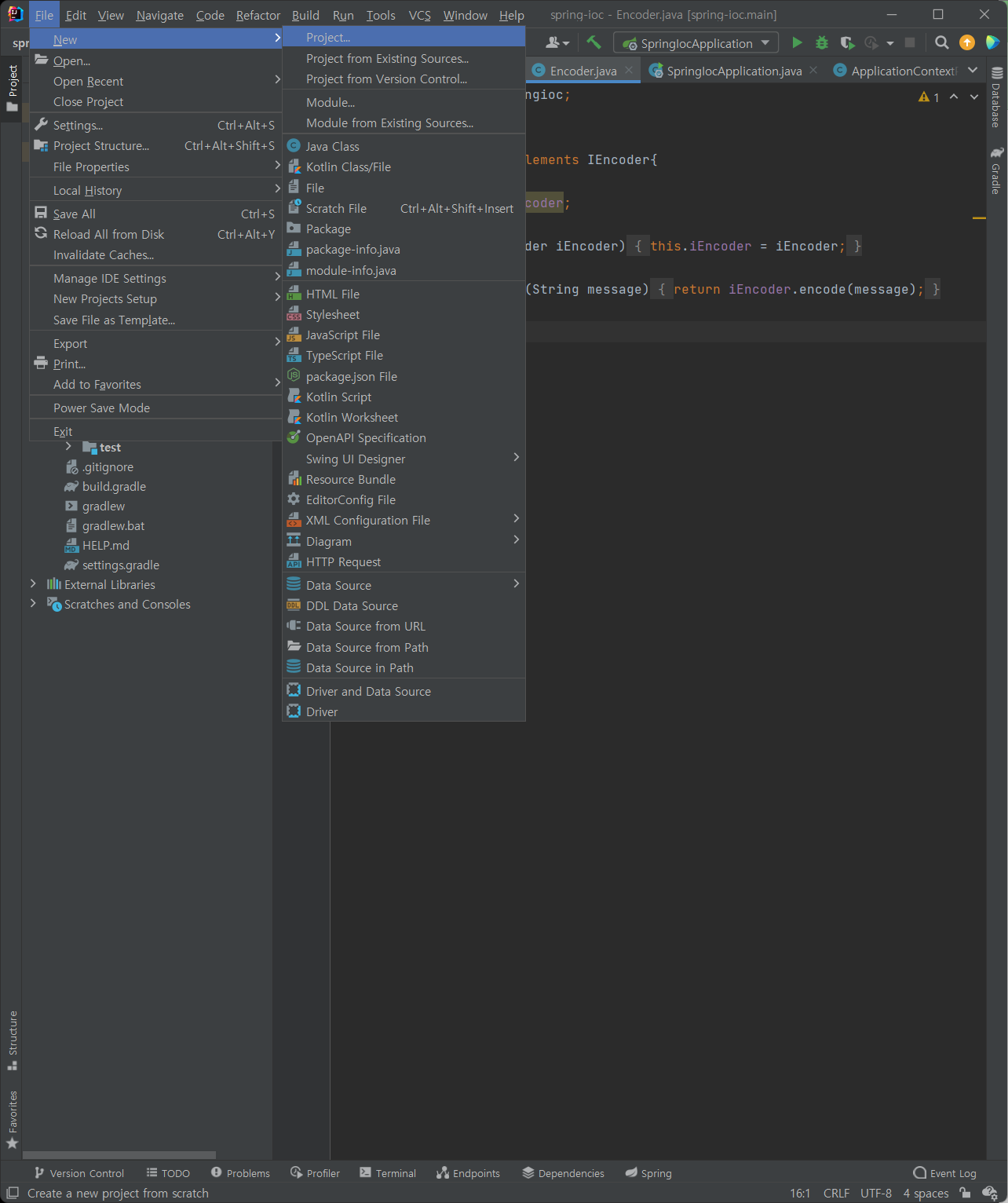


(2) AOP 사용을 위해서는 Dependencies를 추가해야함
: Spring에 있는 수많은 모듈들은 원하는 것만 골라 사용할 수 있다.
: bundle.gradle > (다음 문장 추가) implementation 'org.springframework.boot:spring-boot-starter-aop'
dependencies {
implementation 'org.springframework.boot:spring-boot-starter-aop'
implementation 'org.springframework.boot:spring-boot-starter-web'
testImplementation 'org.springframework.boot:spring-boot-starter-test'
}: 상단의 새로고침 클릭 : BUILD SUCCESSFUL in 860ms
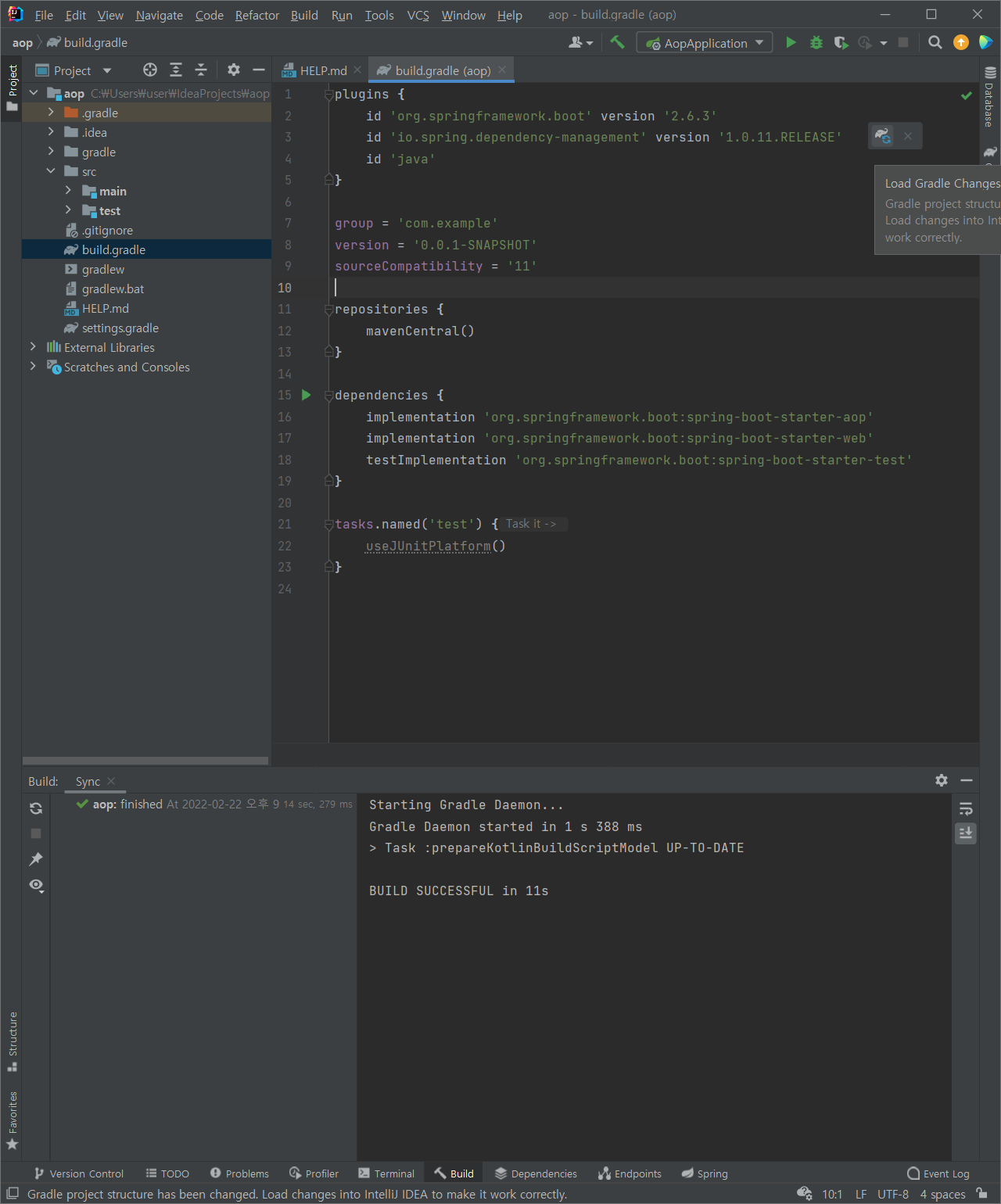
이제 시작해봅시다
(3) controller 패키지 추가 > RestApiController 자바 클래스 추가
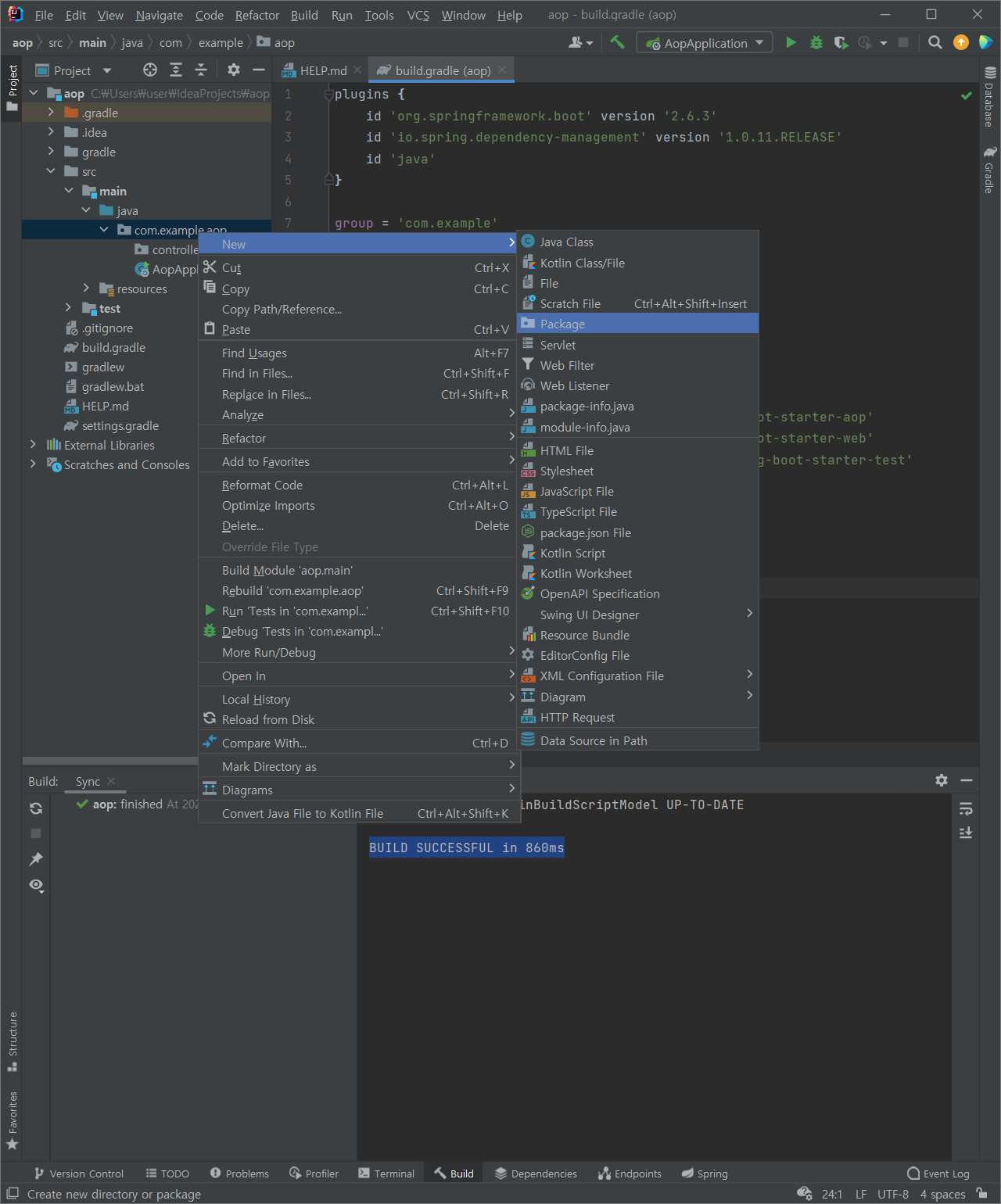

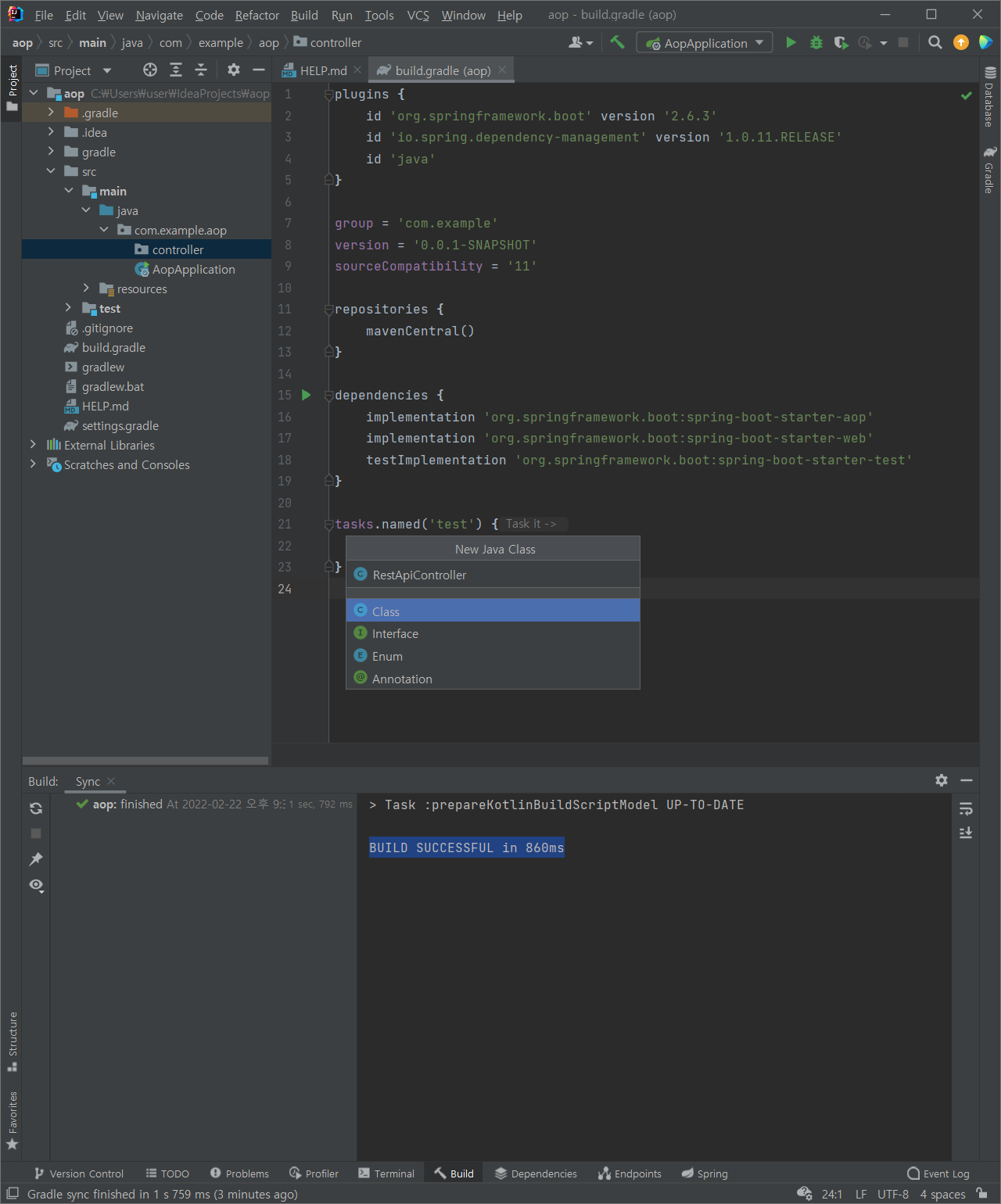
(4) dto 패키지 추가 > User 자바 클래스 추가
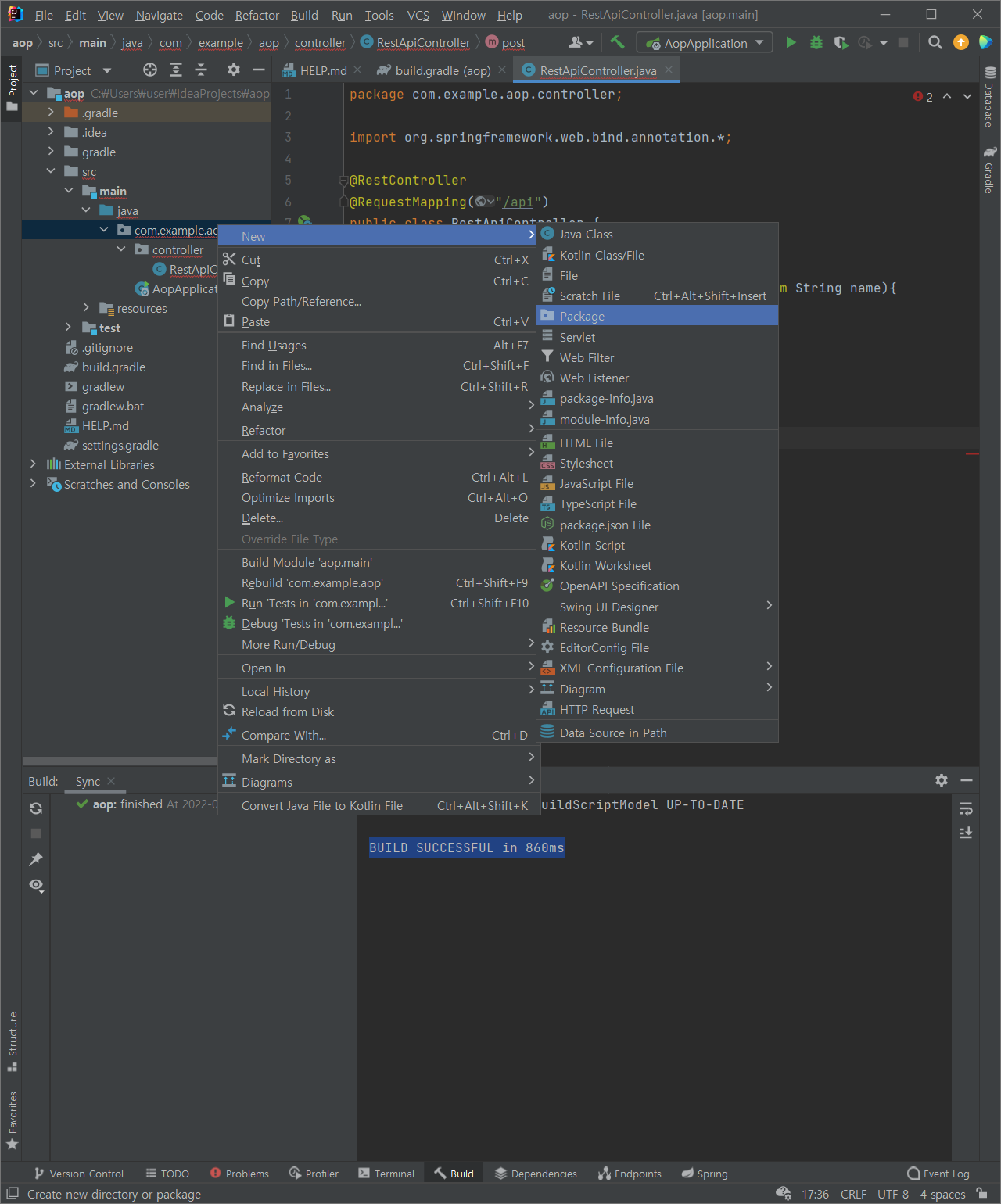
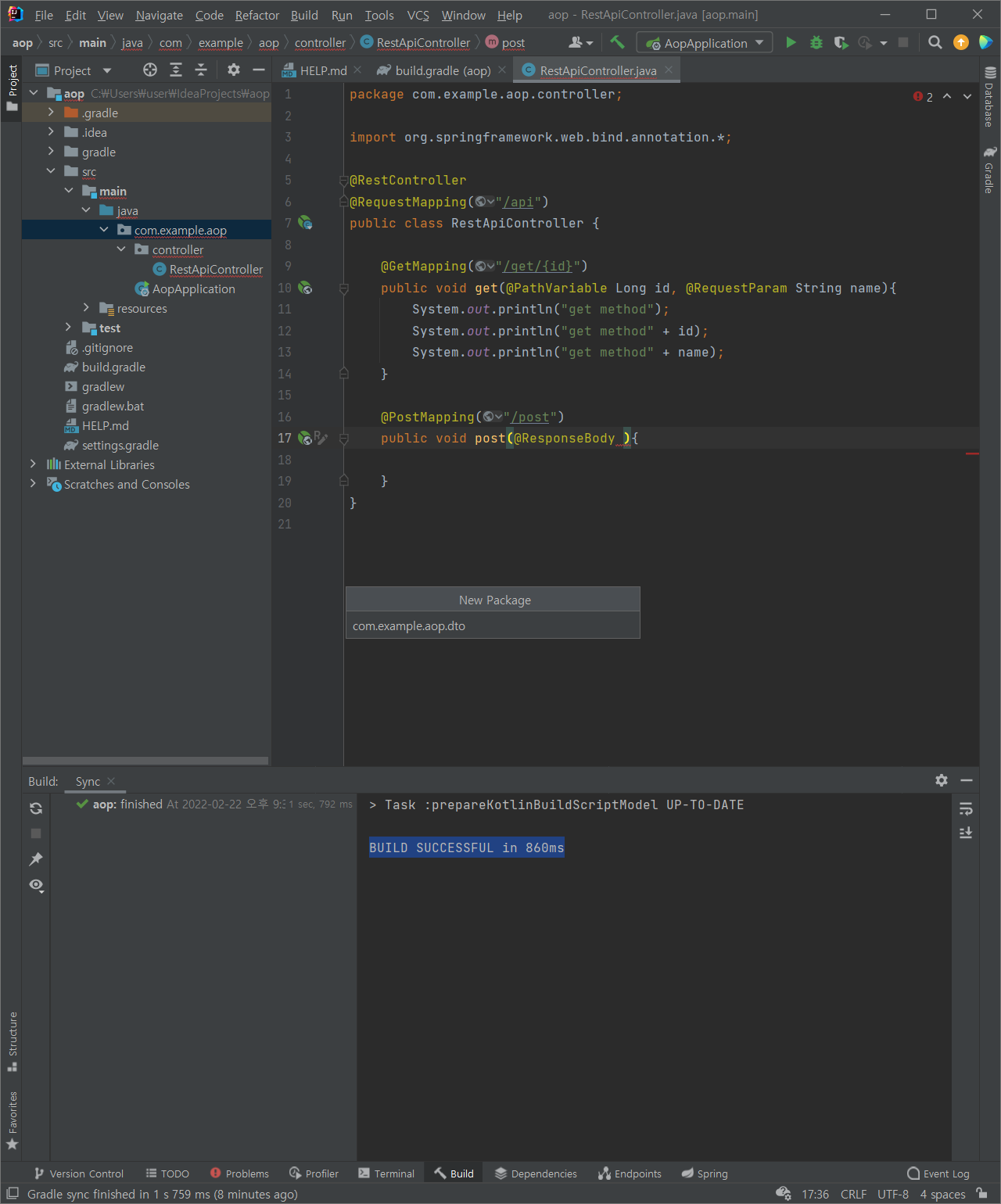

package com.example.aop.dto;
public class User {
private String id;
private String pw;
private String email;
public String getId() {
return id;
}
public void setId(String id) {
this.id = id;
}
public String getPw() {
return pw;
}
public void setPw(String pw) {
this.pw = pw;
}
public String getEmail() {
return email;
}
public void setEmail(String email) {
this.email = email;
}
@Override
public String toString() {
return "User{" +
"id='" + id + '\'' +
", pw='" + pw + '\'' +
", email='" + email + '\'' +
'}';
}
}
(5) RestApiController 클래스 작성
package com.example.aop.controller;
import com.example.aop.dto.User;
import org.springframework.web.bind.annotation.*;
@RestController
@RequestMapping("/api")
public class RestApiController {
@GetMapping("/get/{id}")
public void get(@PathVariable Long id, @RequestParam String name){
System.out.println("get method");
System.out.println("get method" + id);
System.out.println("get method" + name);
}
@PostMapping("/post")
public void post(@RequestBody User user){
System.out.println("post method" + user);
}
}
그럼 테스트를 해봅시다
(6) GET test
Talend API > (GET) http://localhost:8080/api/get/100?name=steve
결과:
get method
get method 100
get method steve
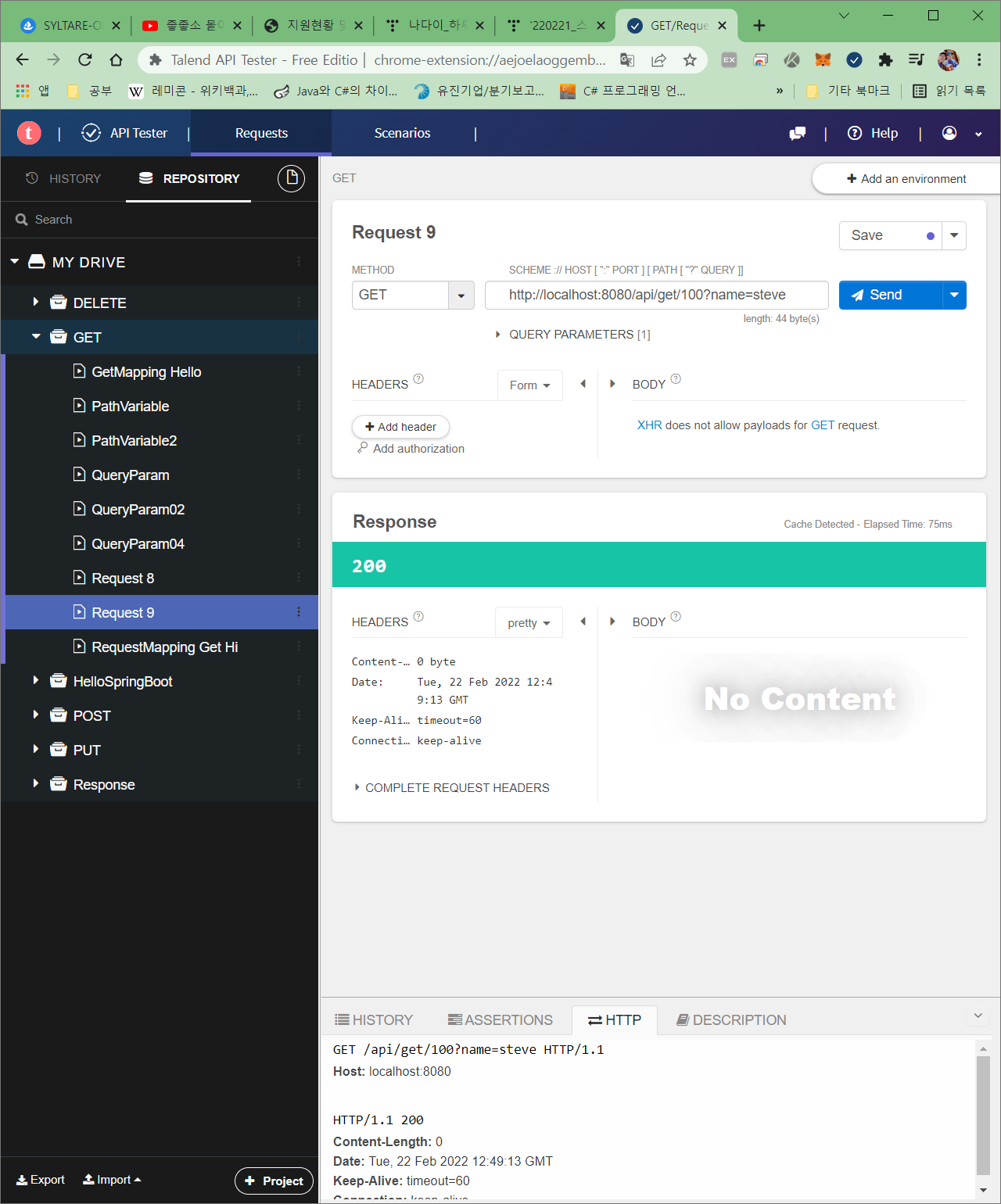
(7) POST test
Talend API > (POST) http://localhost:8080/api/post
body:
{
"id" : "steve",
"pw" : "1234",
"email" : "steve@naver.com"
}결과:
post methodUser{id='steve', pw='1234', email='steve@naver.com'}

그럼 이제 본격 AOP를 시작해 볼까요?
: 각 메소드마다, 로그를 찍는 부분을 한 곳에 모아보자!
(8) aop 패키지 추가 > ParameterAop 클래스 추가
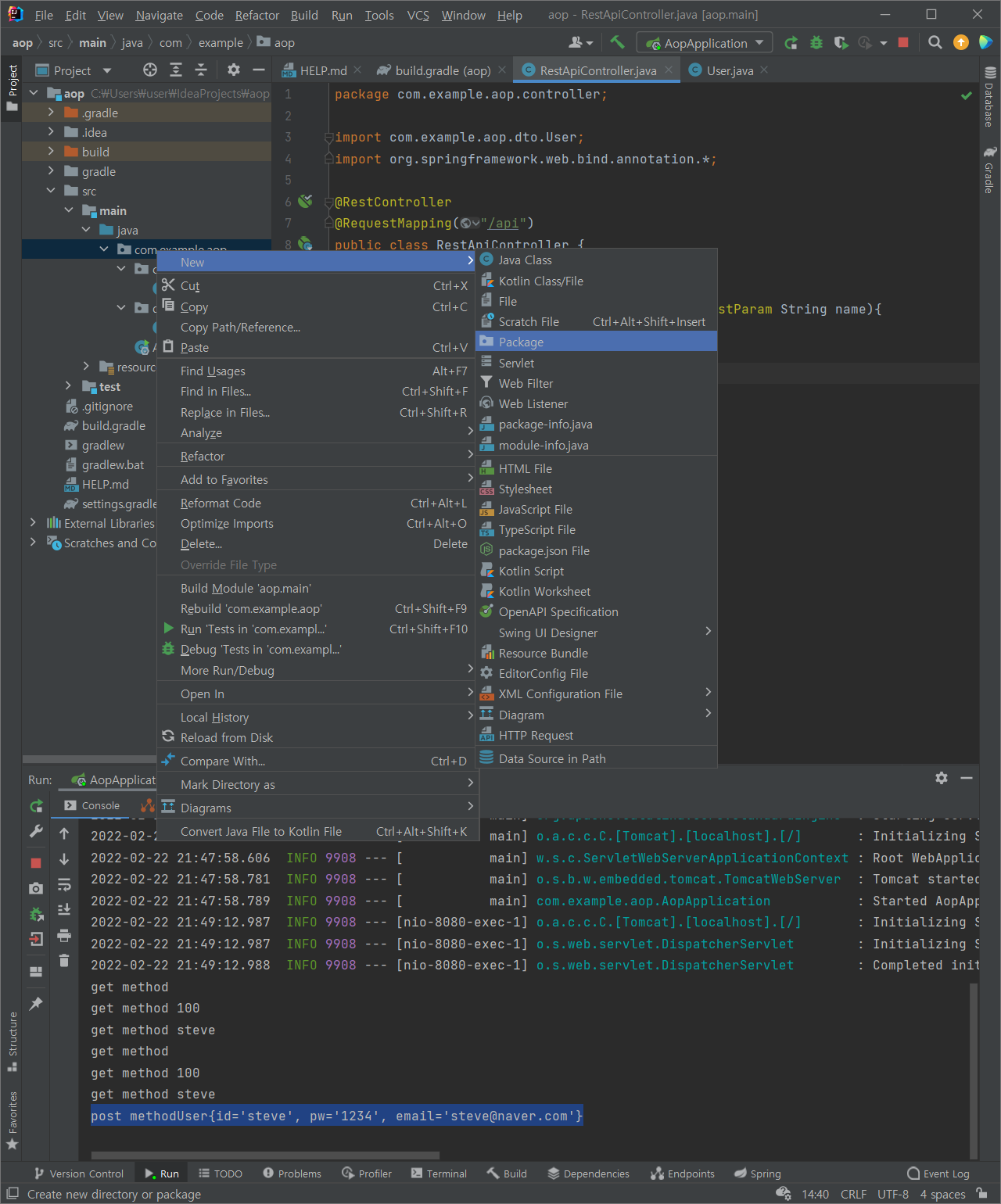
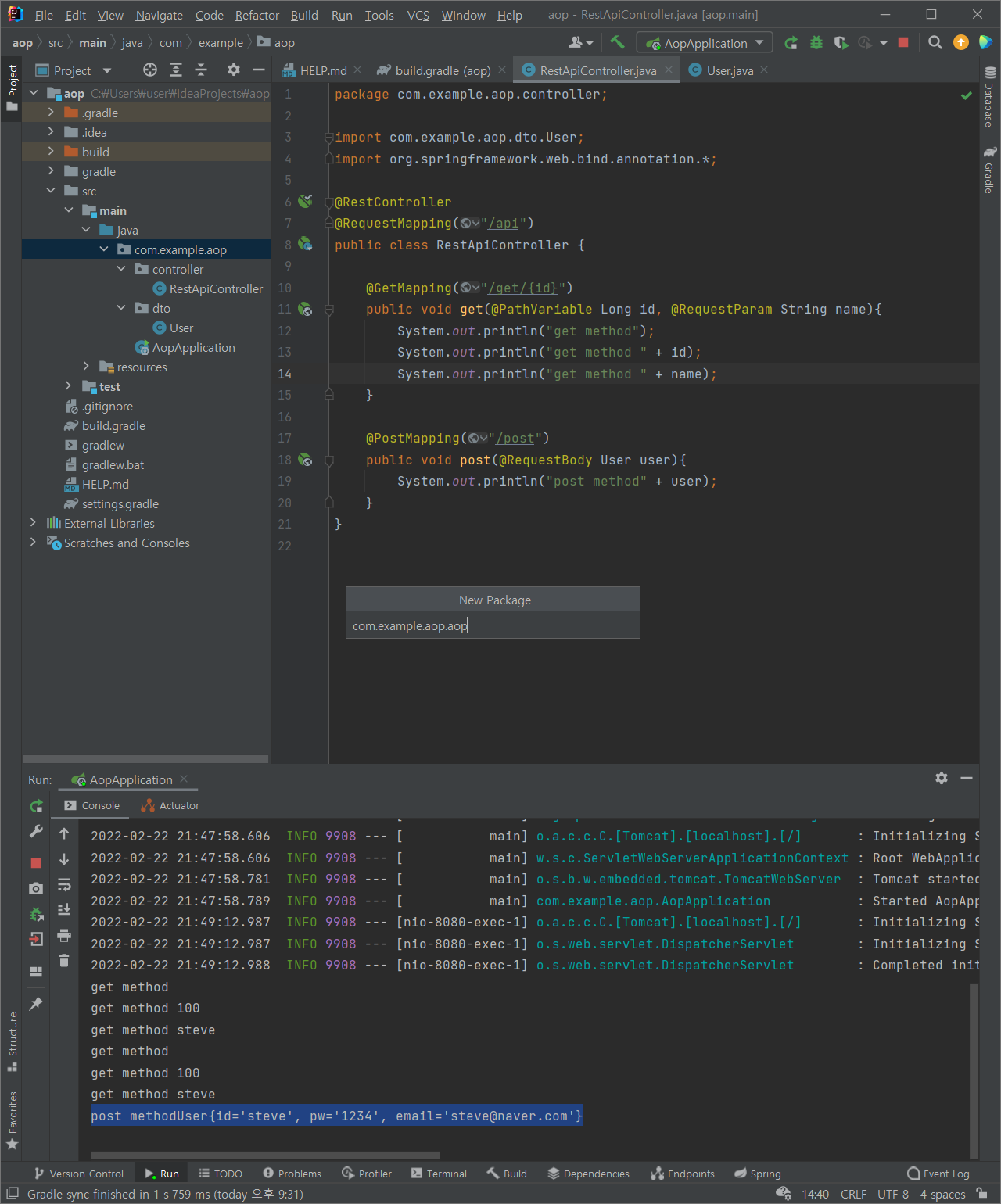
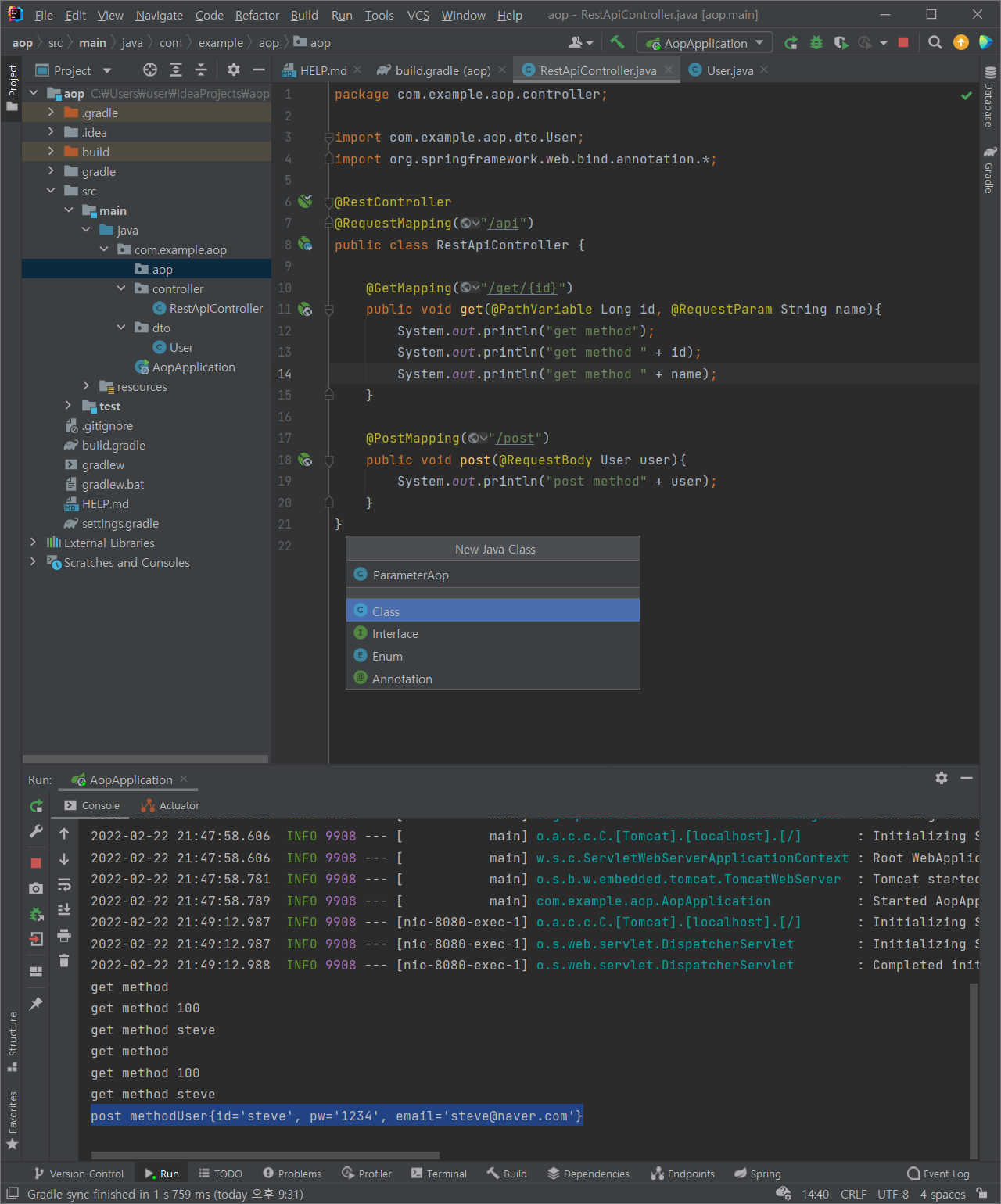
package com.example.aop.aop;
import org.aspectj.lang.JoinPoint;
import org.aspectj.lang.annotation.*;
import org.springframework.stereotype.Component;
@Aspect
@Component
public class ParameterAop {
//controller 패키지 하위를 다 point cut하겠다~
@Pointcut("execution(* com.example..aop.controller..*.*(..))")
private void cut(){
}
@Before("cut()")
public void before(JoinPoint joinPoint){
Object[] args = joinPoint.getArgs();
for(Object obj : args){
System.out.println("type : " + obj.getClass().getSimpleName());
System.out.println("value : " + obj);
}
}
//정상 실행이 되고 return이 되면 해당 returnObj 값을 여기서 볼 수 있다
@AfterReturning(value = "cut()", returning = "returnObj")
public void afterReturn(JoinPoint joinPoint, Object returnObj){
System.out.println("return obj");
System.out.println(returnObj);
}
}
(9) Main문 변경
package com.example.aop.controller;
import com.example.aop.dto.User;
import org.springframework.web.bind.annotation.*;
@RestController
@RequestMapping("/api")
public class RestApiController {
@GetMapping("/get/{id}")
public String get(@PathVariable Long id, @RequestParam String name){
System.out.println("get method");
System.out.println("get method " + id);
System.out.println("get method " + name);
return id + " " + name;
}
@PostMapping("/post")
public User post(@RequestBody User user){
System.out.println("post method" + user);
return user;
}
}
(10) POST test
Talend API > (POST) http://localhost:8080/api/post
body:
{
"id" : "steve",
"pw" : "1234",
"email" : "steve@naver.com"
}결과:
type : User
value : User{id='steve', pw='1234', email='steve@naver.com'}
post methodUser{id='steve', pw='1234', email='steve@naver.com'}
return obj
User{id='steve', pw='1234', email='steve@naver.com'}
에코의 형태로 동작한다!
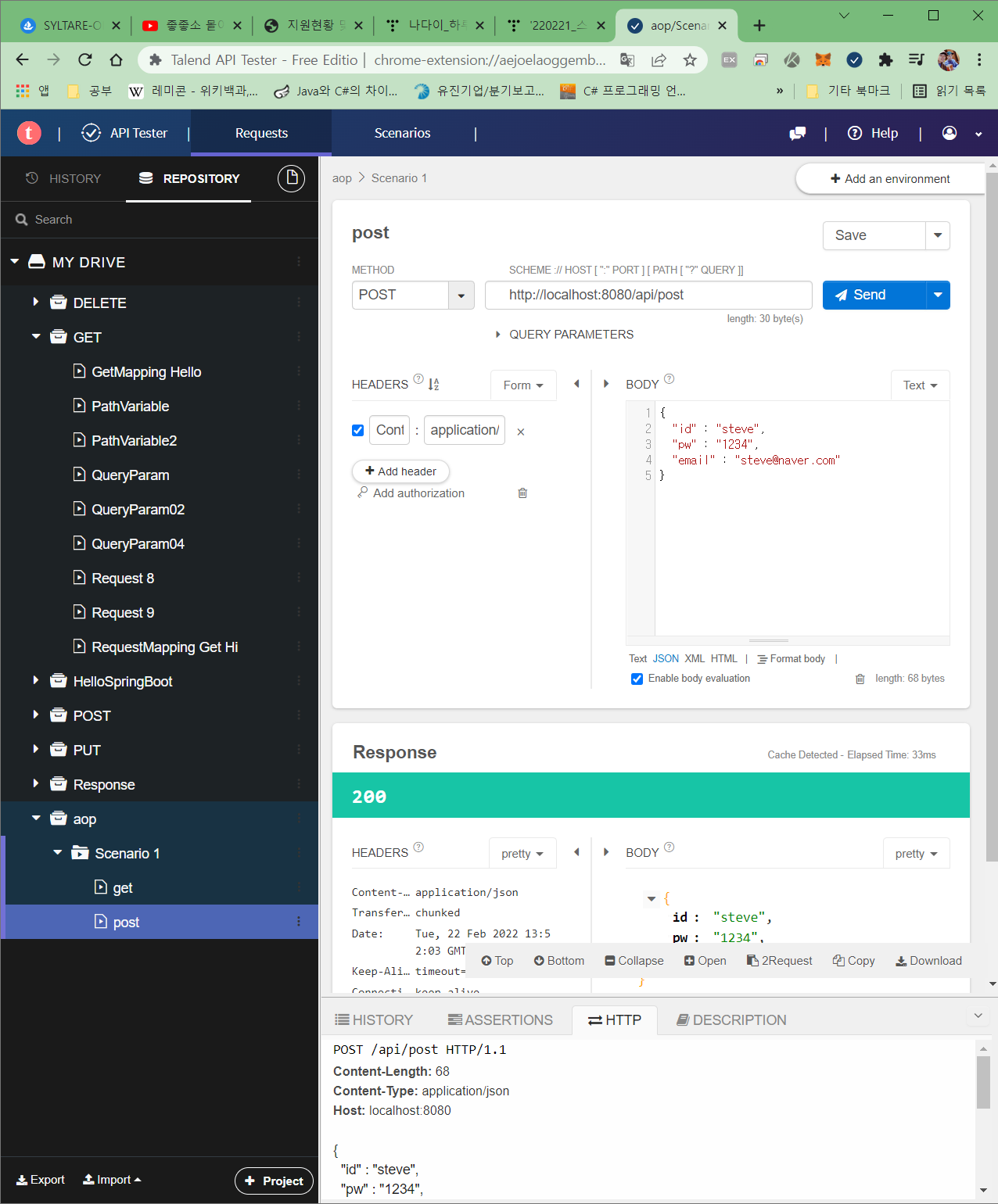
(11) GET test
Talend API > (GET) http://localhost:8080/api/get/100?name=steve
결과:
type : Long
value : 100
type : String
value : steve
get method
get method 100
get method steve
return obj
100 steve

(12) Method 이름 출력하기
//메소드 이름 받아오기
MethodSignature methodSignature = (MethodSignature) joinPoint.getSignature();
Method method = methodSignature.getMethod();
System.out.println(method.getName());메인문은 간결하게 해줍니다. 왜냐? point cut 에서 메시지를 찍어줄 것이기 때문이죠
package com.example.aop.controller;
import com.example.aop.dto.User;
import org.springframework.web.bind.annotation.*;
@RestController
@RequestMapping("/api")
public class RestApiController {
@GetMapping("/get/{id}")
public String get(@PathVariable Long id, @RequestParam String name){
return id + " " + name;
}
@PostMapping("/post")
public User post(@RequestBody User user){
return user;
}
}
결과:
get
type : Long
value : 100
type : String
value : steve
return obj
100 steve
post
type : User
value : User{id='steve', pw='1234', email='steve@naver.com'}
return obj
User{id='steve', pw='1234', email='steve@naver.com'}
정리:
- AOP에서 프로그램의 특정 메소드들이 어떤 값들이 들어갔고, return 됬는지에 대해서 확인 가능하다
- 외부에서 어떤 요청이 들어왔는지, 어떤 메소드가 실행되었는지, 어떤 값이 리턴되었는지 쉽게 확인 가능하다
29일차 강의 완료~

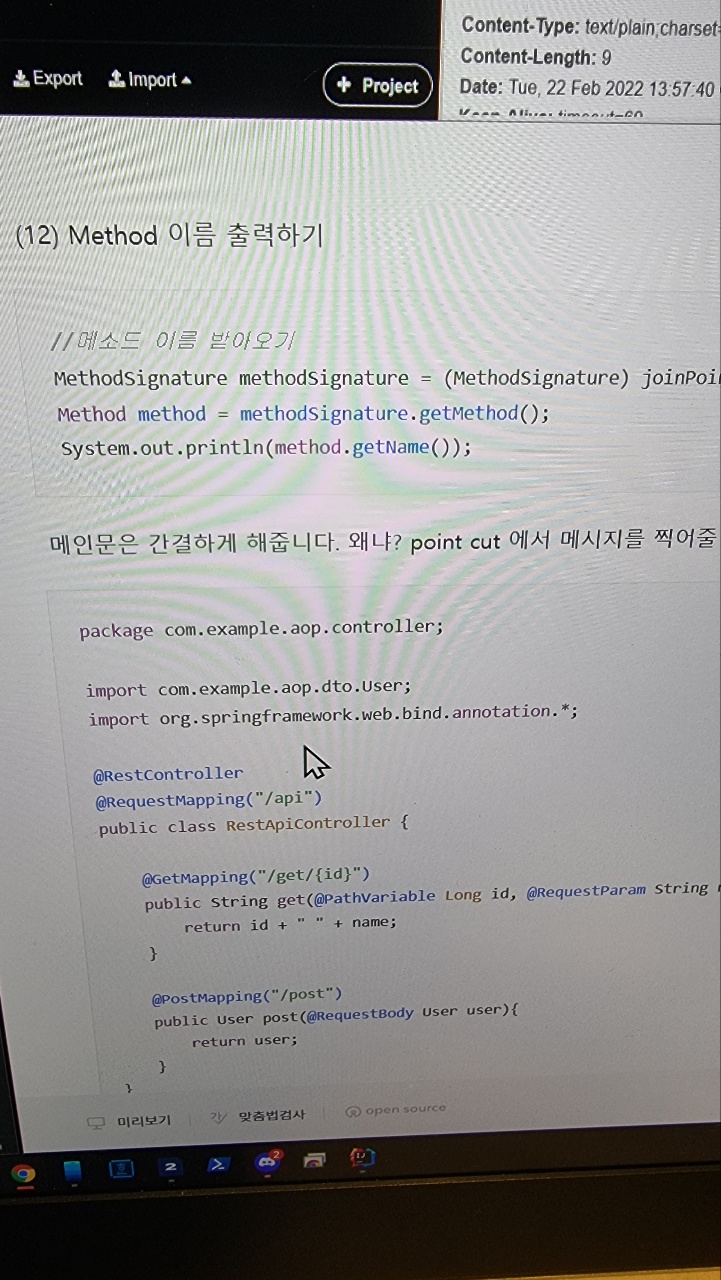
패스트캠퍼스 [직장인 실무교육]
프로그래밍, 영상편집, UX/UI, 마케팅, 데이터 분석, 엑셀강의, The RED, 국비지원, 기업교육, 서비스 제공.
fastcampus.co.kr
본 포스팅은 패스트캠퍼스 환급 챌린지 참여를 위해 작성되었습니다.
'개발새발 > Spring' 카테고리의 다른 글
| 220223_스프링 입문_스프링을 조금 더 들여다보기_ObjectMapper_패스트캠퍼스 챌린지 31일차 (0) | 2022.02.23 |
|---|---|
| 220222_스프링 입문_스프링을 조금 더 들여다보기_AOP 실무 사례 알아보기(2)_패스트캠퍼스 챌린지 30일차 (0) | 2022.02.23 |
| 220220_스프링 입문_스프링을 조금 더 들여다보기_AOP_패스트캠퍼스 챌린지 28일차 (0) | 2022.02.20 |
| 220219_스프링 입문_스프링을 조금 더 들여다보기_IoC, DI(2)_패스트캠퍼스 챌린지 27일차 (0) | 2022.02.19 |
| 220218_스프링 입문_스프링을 조금 더 들여다보기_IoC, DI(1)_패스트캠퍼스 챌린지 26일차 (0) | 2022.02.18 |